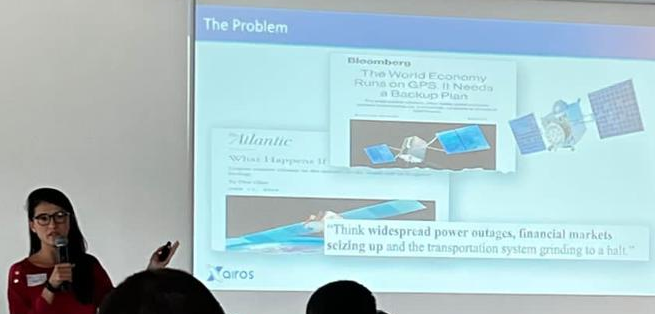
What is Old is New Again
By the end of the 17th century, England had a problem. Their continental rivals were carving up the riches of the new world and the spice trade, and, as a result, held more ships and ports. The English ships couldn’t maneuver around them because they couldn’t figure out their East-West position, which required an accurate knowledge of local time. So they set up the Longitude Act with a cash prize to harness the ingenuity of industry.
Lots of crazy schemes were floated, including a time relay across 600 barges spaced at ten mile intervals. But what if there was fog? What if a pirate took out a barge? A chain is only as strong as its weakest link.
Instead, England developed an network of observatories on "coastlines or ports around the world" to synchronize marine chronometers on passing ships. It was the world’s first synchronization network, and it propelled their domination of the seas and the rise of the British Empire.
The modern world is even more dependent on accurate time synchronization. All networks, data centers, and power grids rely on a timing signal that starts from global navigation satellite systems (GNSS). But in some ways GNSS suffers from the same problems identified centuries earlier; instead of fog, there are RF jamming devices. Instead of pirate ships, there are anti-satellite missiles.
So governments are going back to the private sector to help solve this problem (see below).
Last Week's Theme: Independence Day
- Busy week of meetings at QuantumBasel and elsewhere in Europe. Flurry of partnership activity ahead of summer break!
- Check out our upcoming Time Appliances Project presentation next Wednesday, July 19, at at 11am PST. You can simply join the meeting at: https://meet.goto.com/tap or dial in at: +1- 877-309-2073 using access code: 565-185-493.
- Following up from meetings at World of Quantum, Q4I, Quantum 2.0 Conference and European Navigation Conference, with new partnerships in work.

- Also preparing for presentations and panels at APSCC in October and the International Timing and Sync Forum in November.
- One proposal submitted and another in final prep! Should hear back on their status in Q4.
- Developing new IP and provisional patents to file later this month.
- Our next Investor Sessions are next week so contact us if you want to join!
- Are we “Taking GPS for Granted?” Avionics News thinks so: “The U.S. government isn’t good at tracking interference with GPS signals, and an expert advisory committee on precision, navigation and timing to the government believes GPS is falling behind similar systems in China and Europe.”
- Russian jamming of GPS in Ukraine has been well known as noted in two recent interviews highlighted how effective it has been against guided munitions, even when outfitted with anti-jamming systems. UK’s Royal United Services Institute claims that the jamming “is risking their accuracy” due to “the sheer power of the jamming signal that can be brought to bear." And the Ukrainian Defense Minister also noted that: “The Russians come up with a countermeasure, we inform our partners, and they create a new countermeasure against this countermeasure.”
- And now this Russian GPS jamming has spilled into Estonia, impacting flights.
- Everybody seems to be working on quantum secure networks: researchers announced a “Demonstration of quantum-digital payments” using entangled photons, Vodafone announced a “quantum-safe Virtual Private Network (VPN),” HSBC announced they are “trialing quantum-safe financial transaction network,” and Sweden announced their “Swedish Quantum Agenda.”
- The Fourth of July may be over, but the “Sun is not done yet with the fireworks.” A coronal mass ejection has “a chance to deliver a glancing blow at our planet” tomorrow.
- Time Appliances Project, July 19, virtual
- Euroconsult, September 11 – 15, Paris, France
- APSCC, October 10 – 12, KL, Malaysia
- ITSF, Oct 30 – Nov 2, Antwerp, Belgium
- UK National Quantum Technologies Showcase 2023, Nov 2, London, UK
- SLUSH, Nov 30 – Dec 1, Helsinki, Finland
For going on fifty years, GPS has been the dominant method of time synchronization for the world. There are 6.5 billion GPS receivers installed in nearly every smart phone, vehicle, and network in the world. But, like the time relay barges of yore, the GPS satellites, links, and even the receivers themselves are vulnerable.
This has spurred a movement towards resilience through belts-and-suspender redundancy. Other countries have developed their own GNSS. And the US is following the lessons from the original Longitude Problem and turning to private industry for solutions.
Fundamentally, GPS isn’t going anywhere – it is too embedded in our modern world. Instead, it will be backed up by other systems that effectively “take the bullseye off GPS.”
And the specific timing needs of commercial enterprise users have spawned a multi-billion dollar market for timing and synchronization units. And they are starting to take a belts-and-suspenders approach to removing reliance on any single GNSS by adding multiple quality clocks for holdover and links to multiple signals of opportunity.
History doesn’t necessarily repeat itself – but it often rhymes.
To learn more, please email us or schedule a meeting here.

